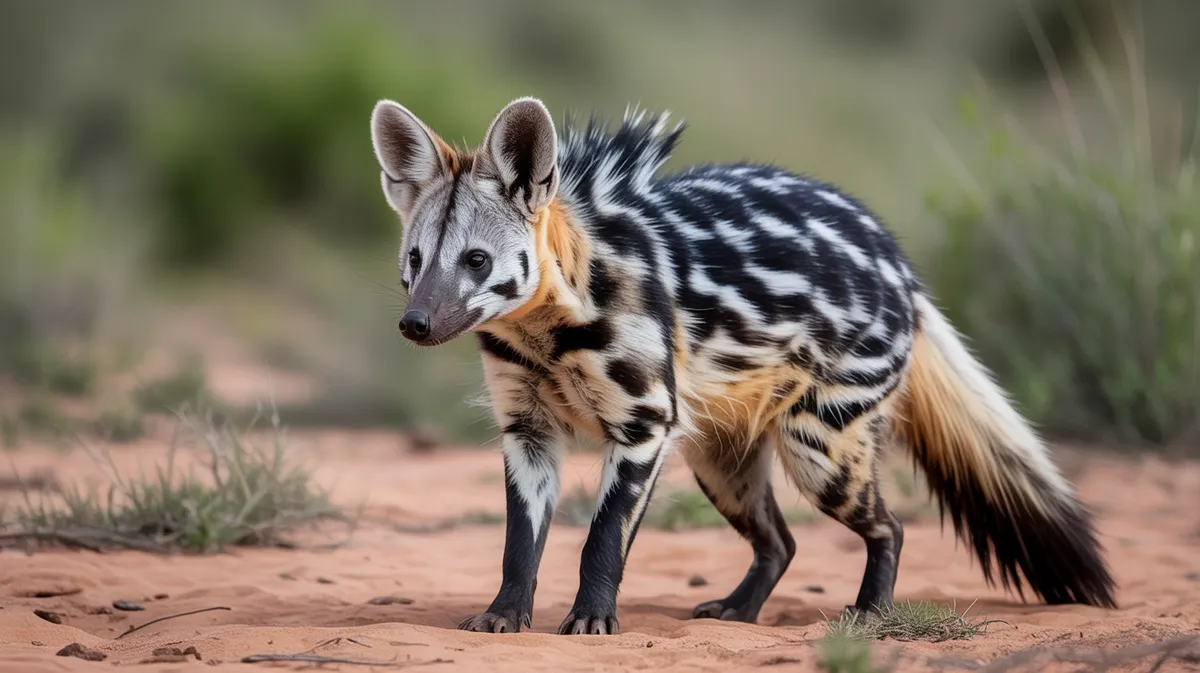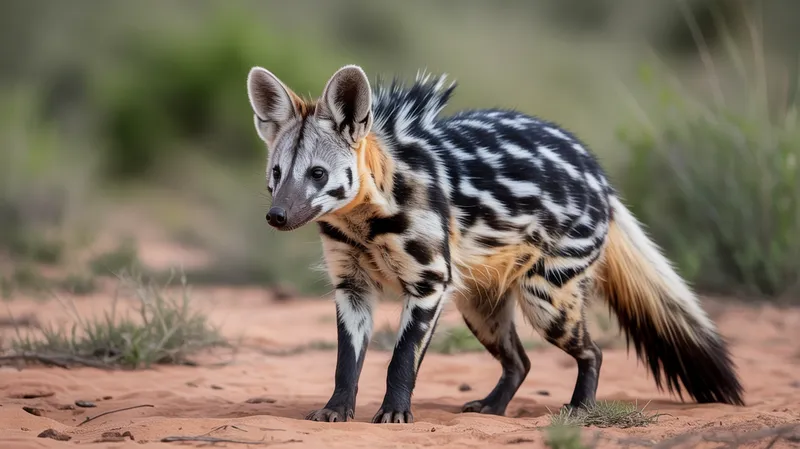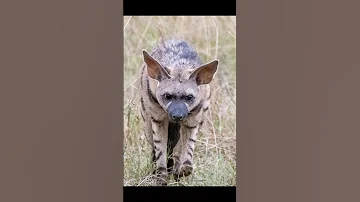
Aardwolf
Proteles cristata

Meet the Aardwolf
The aardwolf is a small, insectivorous mammal native to Eastern and Southern Africa. Despite its hyena-like appearance, it primarily feeds on termites, consuming up to 300,000 in a single night using its long, sticky tongue. Aardwolves are nocturnal and solitary, spending the day in burrows and foraging at night. Unlike true hyenas, aardwolves have weaker jaws and teeth, adapted for their specialized diet rather than for crushing bone.
Classification
Mammal
Habitat
Open savannas and grasslands
Diet
Insectivore
Lifespan
8–10 years in the wild
Conservation
Least Concern
Weight
7–15 kg
📖Fascinating Facts
Termite Specialist
The aardwolf can eat up to 300,000 termites in a single night using its long, sticky tongue.
Nocturnal Lifestyle
Aardwolves are most active at night and spend daylight hours hiding in burrows to avoid predators and the heat.
Unique Teeth
Unlike other hyenas, aardwolves have small, peg-like teeth ideal for eating soft-bodied insects rather than tearing flesh or crushing bone.
📋Detailed Description
The aardwolf (Proteles cristata) is a small, slender member of the family Hyaenidae, standing about 40–50 cm (16–20 in) at the shoulder and weighing between 7–15 kg (15–33 lbs). Its body is covered in coarse, yellowish to gray fur with distinct black stripes running vertically along the flanks, and a characteristic mane of longer hair along the neck and back that can be erected when threatened. Unlike other hyenas, the aardwolf has a narrow skull, reduced cheek teeth, and a long, sticky tongue adapted for lapping up termites, its primary food source. The forelimbs are slightly longer than the hind limbs, giving the back a sloping appearance. Its feet have five toes on the forefeet (unlike the four in other hyenas), aiding in digging. The aardwolf is primarily nocturnal, emerging from its burrow at dusk to forage. It is a solitary forager but may form monogamous pairs that share a territory. The species is non-aggressive, relying on scent marking and vocalizations to communicate. Its anal glands produce a strong-smelling secretion used for marking territory, a trait shared with civets. Aardwolves are highly specialized for insectivory, consuming up to 300,000 Trinervitermes termites in a single night, and rarely drink water, obtaining most moisture from their prey.
💡 Did you know?
Despite belonging to the hyena family, the aardwolf’s main food source is termites, not meat.
🔬Research & Sources
Wikipedia Summary
The aardwolf is an insectivorous hyaenid species, native to East and Southern Africa. Its name means "earth-wolf" in Afrikaans and Dutch. It is also called the maanhaar-jackal, termite-eating hyena and civet hyena, based on its habit of secreting substances from its anal gland, a characteristic shared with the African civet.
Last Modified: 5/25/2025
🎭Behavior & Social Structure
Aardwolves are predominantly nocturnal, spending daylight hours resting in underground burrows, often those abandoned by aardvarks or porcupines. They emerge at dusk to forage alone, following well-established routes within their territory. Their diet is almost exclusively composed of harvester termites (genus Trinervitermes), which they lap up using their long, sticky tongues. They avoid termite species with strong chemical defenses and may shift foraging areas seasonally in response to termite abundance. Aardwolves are generally solitary outside the breeding season, but monogamous pairs may share a territory of 1–4 km², which they defend through scent marking and vocalizations such as yapping or growling. They are non-confrontational, preferring to retreat or erect their mane to appear larger when threatened. During periods of food scarcity, they may become more crepuscular or even diurnal.
👶Reproduction & Life Cycle
Aardwolves are seasonally monogamous, with breeding typically occurring during the rainy season (May–August in southern Africa; November–December in eastern Africa), coinciding with peak termite activity. After a gestation period of approximately 89–92 days, females give birth to 2–5 cubs (average 2–3) in a secluded burrow. Cubs are born blind and helpless, opening their eyes after about 9 days. Both parents participate in rearing, with the male often guarding the den while the female forages. Cubs are weaned at around 3–4 months but may remain in the natal den for up to 6 months. Sexual maturity is reached at 1.5–2 years. Parental investment is high, with frequent grooming and protection from predators such as jackals and large birds of prey.
🛡️Adaptations & Survival
The aardwolf exhibits several unique adaptations for its insectivorous lifestyle. Its dentition is highly reduced, with small, peg-like molars and premolars, and the canines are vestigial, reflecting its non-predatory diet. The elongated, sticky tongue is specialized for efficiently harvesting termites from the ground surface. Enlarged salivary glands produce copious saliva to facilitate termite collection. The digestive tract is adapted to process chitin, the main component of termite exoskeletons. The aardwolf’s acute sense of smell aids in locating termite colonies, while its five-toed forefeet assist in digging if necessary. The erectable mane serves as a visual deterrent against predators. Scent glands produce strong-smelling secretions for territorial marking and communication.
🎨Cultural Significance
The aardwolf is less prominent in African folklore than other hyenas, but its secretive, nocturnal habits have contributed to local myths associating it with witchcraft or supernatural powers. In some regions, it is erroneously believed to be a chicken thief, leading to occasional persecution. The Afrikaans and Dutch name 'aardwolf' means 'earth wolf,' reflecting its terrestrial habits. Its alternative name, 'maanhaar-jackal' (mane-haired jackal), references its distinctive mane. There are no significant traditional uses of the aardwolf in medicine or diet, and it is not commonly hunted for its fur.
🔬Recent Research & Discoveries
Recent research has focused on the aardwolf’s ecological role as a specialized termite predator and its impact on termite population dynamics. Studies using radio telemetry and GPS tracking have revealed detailed patterns of territory use, foraging behavior, and denning ecology. Genetic analyses have clarified its position as the most basal member of Hyaenidae, diverging from other hyenas approximately 10 million years ago. Ongoing research is examining the effects of habitat fragmentation and climate change on aardwolf populations, as well as the chemical composition of its scent gland secretions and their role in social communication. There is also growing interest in the aardwolf’s physiological adaptations to a low-protein, high-chitin diet.
🎥Wildlife Videos

Unmasking the Aardwolf: The Fascinating Creature You've Never Heard Of
In this video, we're going to learn all about the aardwolf! This beautiful creature is definitely worth learning about, and we'll be ...
BEASTFLIX

The aardwolf in Kenya’s Maasai Mara National Reserve #wildlife #africa #africanwildlife #aardwolf
A rare sighting in Kenya's Maasai Mara National Reserve; a rarely seen animal, the Aardwolf. This shy nocturnal animal is a ...
Dave and Sherri Clark

This “Hyena” Doesn’t Hunt—It Eats 300,000 Termites a Night! 😱 Aardwolf
This “Hyena” Doesn't Hunt—It Eats 300000 Termites a Night! Did you know there's a hyena that doesn't scavenge or hunt?
Wildlife Wonder TV

The Aardwolf: A Unique Nocturnal Termite-Eating Marvel of Africa#Aardwolf #AfricanWildlife
Nature'SCHARM

Meet the Mysterious Aardwolf! 🐺✨
Have you ever heard of the Aardwolf? A strange, nocturnal creature that looks like a small hyena but feeds only on insects!
NatGraphy

AARDWOLF - Unveiling the Secrets of Nature's Stealthy Hunter
Watch this video to learn all about the aardwolf, the North American cousin of the African wild dog. In this video, we'll discuss the ...
BEASTFLIX
🌍Habitat Information
The Aardwolf typically inhabits Open savannas and grasslands environments. Aardwolfs have adapted to their environments with specialized features and behaviors.
Primary Habitat:
Open savannas and grasslands
More detailed habitat information will be available soon.
🛡️Conservation Status
The Aardwolf is currently classified as Least Concern. Conservation efforts are crucial for preserving this species for future generations.
Common Threats:
- 🏠Habitat loss and fragmentation
- 🌡️Climate change impacts
- 🎯Hunting and poaching
- 🏭Human-wildlife conflict
⚠️Threats & Conservation Challenges
Currently classified as Least Concern by the IUCN, the aardwolf faces localized threats including habitat loss due to agricultural expansion, overgrazing, and urbanization. Pesticide use can reduce termite populations, indirectly impacting aardwolf food resources. In some regions, aardwolves are persecuted due to mistaken beliefs that they prey on livestock or poultry, though such incidents are rare. Road mortality and predation by larger carnivores (e.g., lions, leopards, hyenas) and domestic dogs also pose risks. Population trends are generally stable, but fragmentation and localized declines have been reported in areas of intense land use.
🔬Scientific Classification
Scientific Name
Proteles cristata
Classification Hierarchy
🔍 About Taxonomic Classification
Taxonomic classification is a hierarchical system used by scientists to classify and organize living organisms based on shared characteristics and evolutionary relationships.
The system moves from broad categories (Kingdom) to increasingly specific ones, with each animal's scientific name typically consisting of its Genus and species.
📝Community Notes
Share your observations and insights about the Aardwolf with our community of wildlife enthusiasts.
Join Our Community
Sign in to share your observations and connect with fellow wildlife enthusiasts.
Sign In to ContributeNo community notes yet
Be the first to share your observations about the Aardwolf!
Explore Aardwolf
Select a tab above to learn more about this amazing animal.
📸Photo Gallery
No photos available for this animal yet.
🌟Discover More Wildlife
Continue your journey of discovery with more fascinating animals from our database
